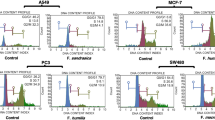Abstract
When SiHa cells were incubated for varying periods of time with extracts of PFF and PFM, the cytotoxicity of the ethanol extracts of PFF was higher than those of the other extracts. These results indicated that the extracts from fruiting bodies ofP. ferulae contain antitumor substances. When A549, SiHa and HeLa cells were incubated with different concentrations of PFF and PFM extracts, the ethanol extracts of PFF showed strong cytotoxicity against A549 cells at concentrations over 10 μg/mL and against SiHa and HeLa cells at concentrations over 40 μg/mL. However, the differences in the cytotoxic effects of the hot water and ethanol extracts of PFM and the hot water extracts of PFF on all 3 cancer cells were not significant. Also, the PFF ethanol extracts induced synergistic effects on the TRAIL-induced apoptosis in A549 cells, which were strongly resistant to TRAIL. These results indicated that ethanol extracts of PFF were the most prominent antitumor agents toward lung cancer cells (A549).
Similar content being viewed by others
References
Mizuno, T., P. Yeohlui, T. Kinoshita, C. Zhuang, H. Ito, and Y. Mayuzumi (1996) Antitumor activity and chemical modification of polysaccharide from Niohshimeji mushroom,Tricholoma giganteum.Biosci. Biotechnol. Biochem. 60: 30–33.
Lorenzen, K. and T. Anke (1998) Basidiomycetes as a source for new bioactive natural products.Curr. Org. Chem. 2: 329–364.
Borchers, A. T., J. S. Stern, R. M. Hackman, C. L. Keen, and E. M. Gershwin (1999)Mushrooms, Tumors, and Biologically Active Substances. Pergamon Press, New York, USA.
Tzianabos, A. O. (2000) Polysaccharide immunomodulators as therapeutic agents; structural aspects and biological function.Clin. Microbiol. Rev. 13: 523–533.
Chang, S. T. and P. G. Miles (1989)Edible Mushrooms and Their Cultivations. CRC Press Inc, Boca Raton, Florida, USA.
Breene, W. M. (1990) Nutritional and medicinal value of specially mushrooms.J. Food Protection 53: 83.
Wasser, S. P. and A. L. Weis (1999) Medicinal properties of substances occurring in higher Basidiomycetes mushrooms: Current perspectives.Int. J. Med. Mushrooms 1: 31–62.
Ooi, V. E. C. and F. Liu (1999) A review of pharmacological activities of mushroom polysaccharides.Int. J. Med. Mushrooms 1: 195–206.
Mizuno, T., K. Ohsawa, N. Hagiwara, and R. Kuboyama (1986) Fractionation and characterization of antitumor polysaccharides from maitakeGrifola frondosa.Agric. Biol. Chem. 50: 1679–1688.
Ohno, N., Y. Adachi, L. Suzuki, K. Sato, S. Oikawa, and T. Yadomae (1986) Characterization of the antitumor glucan obtained from liquid culturedGrifola frondosa.Chem. Pharm. Bull. 34: 1709–1715.
Czop, J. K. and J. Kay (1991) Isolation and characterization of β-glucan receptors on human mononuclear phagocytes.J. Exp. Med. 173: 1511–1520.
Yanaki, T., W. Ito, and T. Kojima (1981) Ultrasonic degradation of schizophyllan, an antitumor polysaccharide produced bySchizophyllum commune FRIES.Carbohydr. Res. 89: 121–135.
Gunde-Cimerman, N. (1999) Medicinal value of the genusPleurotus (Fr.) P. Karst.Int. J. Med. Mushroom. 1: 69–80.
Noda, S. (1998) Antibiotic fungicide extracted from Basidiomycetes culture (e.g. Shitake,Flammulina velutips, Polyporus, Pleurotus, etc.). Japanese Patent 60,190,800.
Wang, H. and T. B. Ng (2000) Isolation of a novel ubiquitin-like protein fromPleurotus ostreatus mushroom with anti-human immunodeficiency virus, translation-inhibitory and ribonuclease activities.Biochem. Biophys. Res. Commun. 275: 810–816.
Noda, S. (1990) A preparation for kidney treatment possessing anti-inflammatory activity, obtained fromBasidiomycetes, e.g. Lentinus, Pleurotus, Flammulina, andTricholoma. Japanese Paten 61,171,428.
Opletal, L., L. Jahodar, V. Chabot, P. Zdansky, J. Lukes, M. Bratova, D. Solichova, G. Blunden, C. G. Dacke, and A. Patel (1997) Evidence for the anti-hyperlipidaemic activity of the edible fungusPleurotus ostreatus.Br. Biomed. Sci. 54: 240–243.
Suzuki, W. and T. Ikegawa (1998) Anti-cancer substance emitanin.Japanese Patent 53,006,494.
Paulik, S., S. Svreck, J. Mojzisova, A. Durove, Z. Benishek, and M. Huska (1996) The immunomodulatory effect of the soluble fungal glucan (Pleurotus ostreatus) on delayed hypersensitivity and phagocytic ability of blood leukocytes in mice.Zentrabl Vecterinaermed Reihe B. 43: 129–135.
Pitti, R. U., S. A. Marsters, S. Ruppert, C. I. Donahue, A. Moore, and A. Ashkenazi (1996). Induction of apoptosis by Apo-2 ligand, a new member of the tumor necrosis factor cytokin family.J. Biol. Chem. 271: 1267–1290.
Guchelaar, H. J., A. Vermes, I. Vermes, and C. Haaden (1997) Apoptosis: Molecular mechanism and implication for cancer chemotherapy.Pharm. World Sci. 19: 119–125.
Author information
Authors and Affiliations
Corresponding author
Rights and permissions
About this article
Cite this article
Choi, D., Cha, WS., Kang, SH. et al. Effect ofPleurotus ferulae extracts on viability of human lung cancer and cervical cancer cell lines. Biotechnol Bioproc E 9, 356–361 (2004). https://doi.org/10.1007/BF02933057
Received:
Accepted:
Issue Date:
DOI: https://doi.org/10.1007/BF02933057




